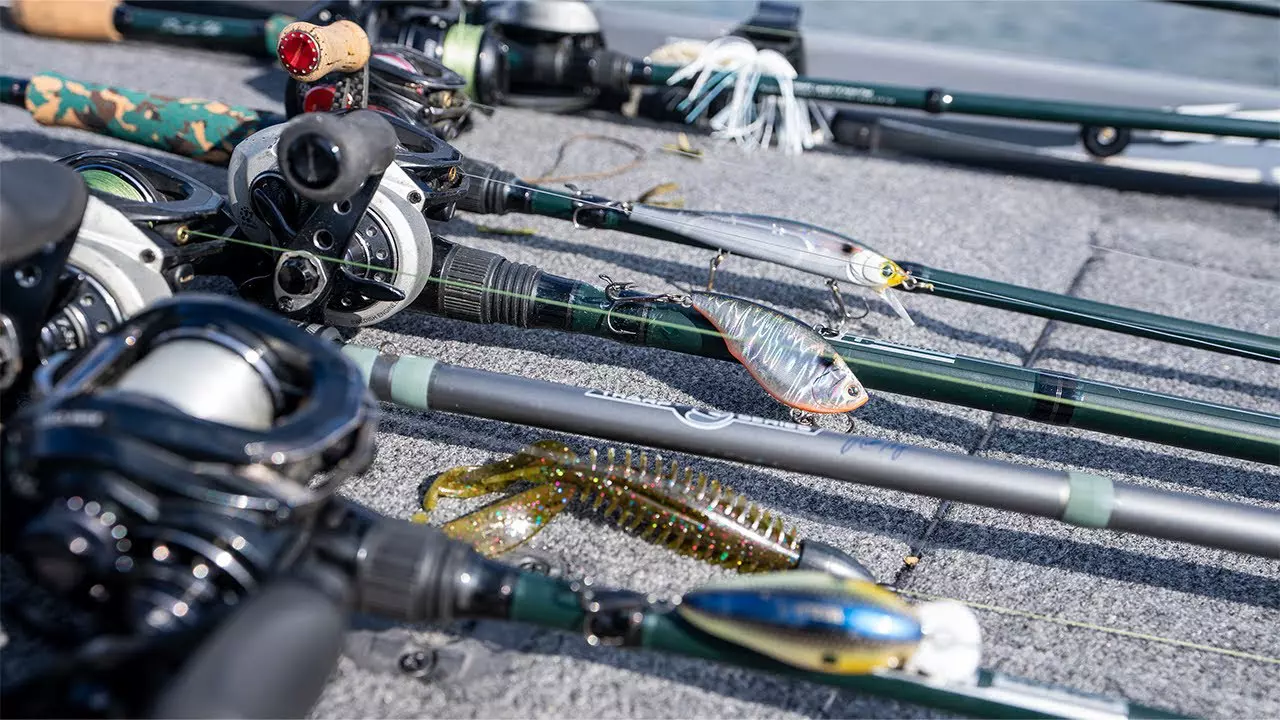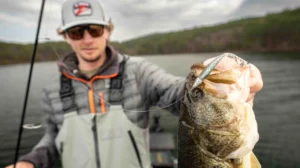You only need a handful of proven lures to dial the fall bass bite on grass lakes. Pro bass angler Brandon Cobb shares his entire roster of fall bass lures for lakes and reservoirs in the Southeast that span early, mid, and late fall transitions. As Cobb explains, grass thickness is a crucial determinant of which bait you should have tied on for any given situation.
For impoundments like Lake Guntersville, fall lure selection revolves around the transition from mat fishing (early fall) to outside edge grass fishing (mid-to-late fall). Healthy grass mats hold loads of bass until the grass dies off, which pushes bass to the outer edges. Specific lures perform best based on grass thickness, depth, and the fish’s mood. These setups will have you covered! *Featured product links at the bottom.
Cobb’s core fall bass lures and rod setups:
-
Frog and punching setup.
Cobb relies on the tried and true hollow-body frog and a pitching setup when bass are in mats or heavy grass. He doesn’t obsess about frog color, so choose your confidence bait and get after it with a heavy casting setup and braid. He goes subsurface with a conventional flipping setup rigged with either a Zoom Z-Craw or Z-Hog and adjusts weight based on mat thickness.
-
Buzzbait around scattered grass.
Cobb loves a buzzbait until water temps descend below 60 degrees. A buzzbait gets big bites and fishes clean over and around grass, making it an excellent search bait. He prefers fishing buzzbaits with a toad, as the bulkier plastic and legs allow you to slow the bait down depending on water temperatures. Cobb likes a heavy power rod with some tip for a blend of backbone but without pulling the bait out of the fish’s mouth.
-
Finesse crankbait.
A small crankbait is an excellent search bait in and around thinning grass and is a top pick when small forage is on the menu. A small profile round-billed bait comes through the grass with relative ease. Cobb chooses a bait that performs in the grass and adjusts running depth by changing line size. A smaller casting reel on a jerkbait rod gets it done.
-
Lipless crankbait.
Simply put, a lipless crankbait excels around grass, and Cobb uses them with year-round success. Line size is essential. Go too heavy, and you kill the bait’s action. Too light, the bait runs too deep and gets buried in the grass. That’s why Cobb advocates 16-pound fluorocarbon as the best all-around option. He uses them on a composite rod to improve hook retention.
-
Jerkbait.
It’s the “get bit” bait when you need that extra triggering action. Cobb focuses his jerkbait efforts around grass edges, especially when the bite is tough. Stay on the edges with it, with deep-diving jerkbaits excelling in cold water, or fish over the grass tops with shallow running models. The bottom line is jerkbaits get bit when other baits fail to trigger bites — they also carry over from the fall to winter bite.
FEATURED FALL BASS LURES (retail links)
FROG SETUP
- FROG – SPRO Dean Rojas Bronzeye Frog 65
- ROD – ARK Cobb Series “Old Faithful” Casting Rod, 7’3″ Mag MH
- REEL – Abu Garcia Revo STX LP Casting Reel
- LINE – Yo-Zuri Braid, 50-pound
FLIPPING SETUP
- BAIT – Zoom Z Craw
- WEIGHT – ARK Fishing Insert Tungsten Flippin Weight
- ROD – ARK Tharp Series “Guntersville Special” Casting Rod, 7’11” H
- REEL – Abu Garcia Revo STX LP Casting Reel
- LINE – Yo-Zuri Braid, 50-pound
BUZZBAIT SETUP
- BUZZBAIT – Greenfish Tackle Toad Toter
- TRAILER – Zoom Horny Toad
- ROD – ARK Cobb Series “Buzz Burner” Casting Rod, 7’1″ H
- REEL – Abu Garcia Revo STX LP Casting Reel
- LINE – Yo-Zuri Braid, 50-pound
CRANKBAIT SETUP
- CRANKBAIT – Yo-Zuri 3DS Shallow Diver
- ROD – ARK Cobb Series “Century” Casting Rod, 6’11” M
- REEL – Abu Garcia Zenon MG-X Casting Reel (Replaces MGX)
- LINE – Yo-Zuri T-7 Premium Fluorocarbon
LIPLESS CRANKBAIT SETUP
- LIPLESS – Yo-Zuri Rattlin Vibe
- ROD – ARK Cobb Series “Good Vibes” Casting Rod, 7’3″ MH/Glass
- REEL – Abu Garcia Revo STX LP Casting Reel
- LINE – Yo-Zuri T-7 Premium Fluorocarbon
JERKBAIT SETUP
- JERKBAIT – Yo-Zuri 3DB Series Jerkbait SP 110
- ROD – ARK Cobb Series “Century” Casting Rod, 6’11” M
- REEL – Abu Garcia Zenon MG-X Casting Reel (Replaces MGXtreme)
- LINE – Yo-Zuri T-7 Premium Fluorocarbon












